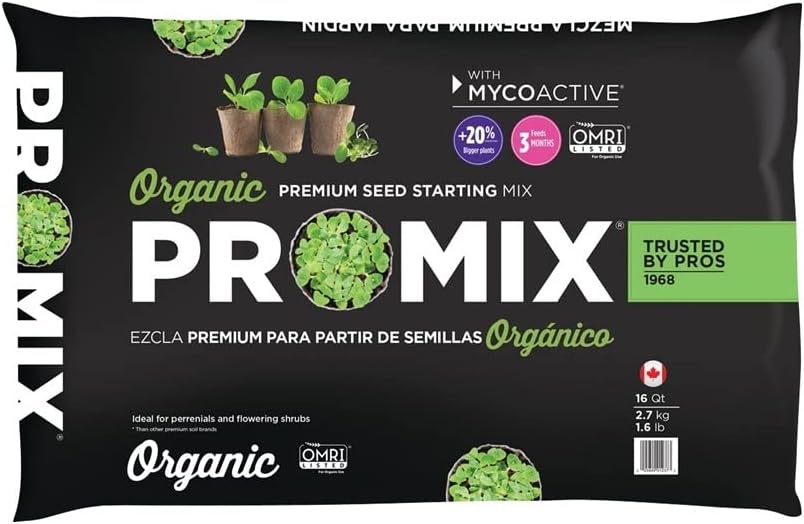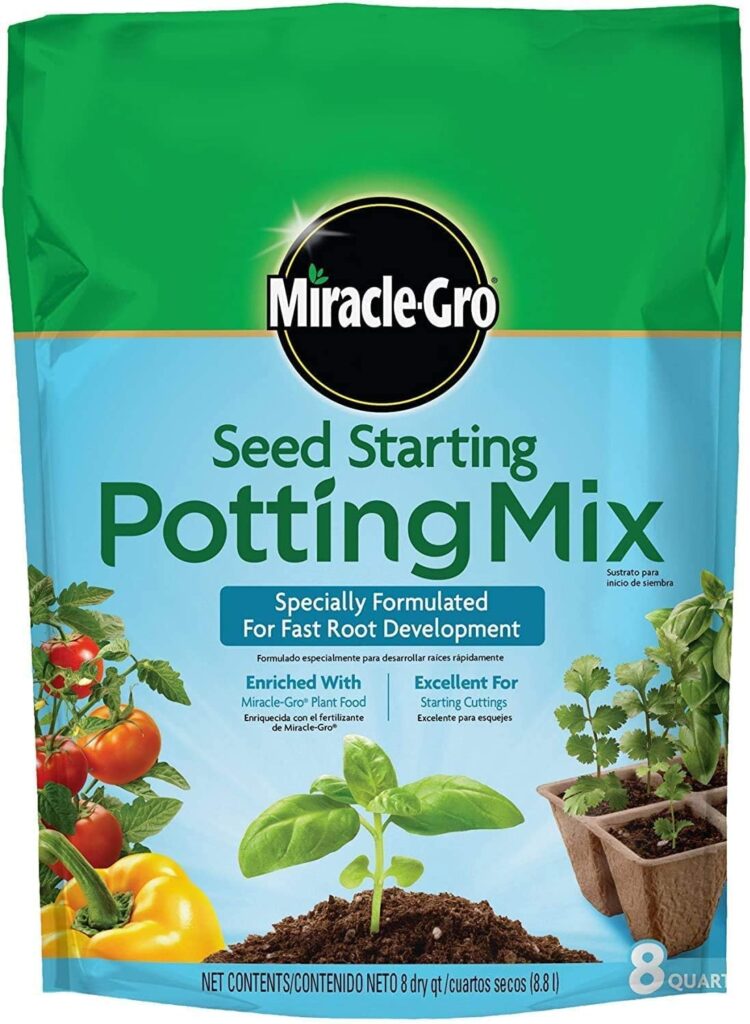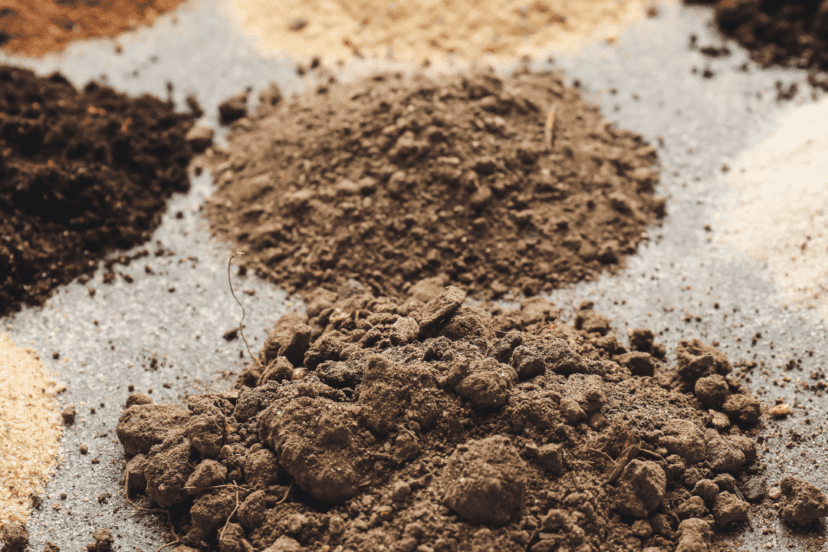Choosing the Best Soil Mix for Microgreens
"We may earn a commission for purchases made using our links. Please see our disclaimer to learn more."
Introduction
Microgreens have gained immense popularity among gardening enthusiasts and health-conscious individuals alike. These young, nutrient-packed greens are not only easy to grow but also bursting with flavor and nutritional benefits. One of the critical factors in successfully cultivating microgreens is choosing the right soil mix. In this article, I’ll guide you through the different types of soil mixes suitable for microgreen cultivation, providing recommendations and insights to help you make the best choice for your green endeavors.
Types of Soil Mixes for Microgreens
When it comes to soil mixes for microgreens, there are several options to consider, each with its own set of advantages and considerations. Let’s explore some of the most popular choices:
Organic Soil Mixes
Organic soil mixes, such as Espoma’s Organic Seed Starter Premium Potting Mix, provide a natural, chemical-free foundation. For those seeking excellent water retention, peat-based mixes like Black Gold’s All Purpose Potting Soil are a reliable option. Additionally, FoxFarm’s Ocean Forest Potting Soil offers a premium blend with enhanced aeration, while Pro-Mix’s Organic Seed Starting Mix is designed by horticulture experts. Miracle-Gro’s Seed Starting Potting Mix provides accessibility and balanced nutrients.
Peat-Based Mixes
Peat-based mixes, derived from decomposed plant material, are known for their excellent water retention properties. They provide a stable environment for microgreen roots to establish themselves. However, it’s essential to be mindful of potential environmental impacts associated with peat extraction.
Coco Coir Blends
Coco coir, a by-product of coconut husks, has gained popularity as a sustainable alternative to traditional soil. Blends that incorporate coco coir offer excellent moisture retention while maintaining optimal aeration for microgreen roots.
Homemade Combinations
For those who prefer a hands-on approach, creating a custom soil mix at home can be a rewarding endeavor. Compost-based mixes and vermicompost blends are popular choices, allowing you to control the composition to suit your microgreen varieties.
Characteristics of an Ideal Soil Mix
Regardless of the type chosen, an ideal soil mix for microgreens should exhibit certain characteristics:
Adequate Drainage
Effective drainage prevents waterlogged soil, which can lead to root rot and other issues. A well-draining soil mix ensures that excess moisture moves away from the roots, promoting healthy growth.
Nutrient-Rich Composition
Microgreens rely on the soil for their initial nutrient supply. A balanced mix with essential nutrients like nitrogen, phosphorus, and potassium is crucial for robust growth.
pH Balance
Maintaining the right pH level is vital for nutrient absorption. A slightly acidic to neutral pH (around 6.0-7.0) is generally optimal for most microgreens.
Pros and Cons of Commercial Soil Brands 🌱
Now, let’s delve into some popular commercial soil brands and their respective merits and drawbacks.
Espoma Organic Seed Starter Premium Potting Mix
Recommendation:
Espoma offers a range of organic soil mixes that are well-suited for microgreen cultivation. Known for their commitment to natural and sustainable gardening practices, Espoma provides a reliable option for growers seeking high-quality soil.
Pros ✅:
- Organic Formulation: Espoma’s soil mixes are made from natural and organic materials, ensuring a chemical-free environment for your microgreens.
- Well-Balanced Nutrients: The mixes are carefully formulated to provide essential nutrients for healthy microgreen growth.
- Trusted Brand: Espoma has a strong reputation in the gardening community for producing reliable and effective soil products.
Cons ❌:
- Availability: Depending on your location, Espoma products may not be as widely available as some other brands.

FoxFarm Ocean Forest Potting Soil
Recommendation:
FoxFarm is a well-known brand in the gardening industry, and their soil mixes are favored by many growers. Their blends are designed to promote robust plant growth and are suitable for various types of plants, including microgreens.
Pros ✅:
- High-Quality Ingredients: FoxFarm uses premium organic ingredients in their soil mixes, ensuring a nutrient-rich growing medium for microgreens.
- Enhanced Aeration: Their blends often contain ingredients like perlite and coconut coir, promoting good aeration and root development.
- Established Brand: FoxFarm is a trusted name in the gardening community, known for producing reliable and effective soil products.
Cons ❌:
- Price: FoxFarm products may be on the higher end in terms of cost, but many growers find the quality justifies the investment.

Black Gold All Purpose Potting Soil
Recommendation:
Black Gold offers a range of quality soil mixes suitable for microgreen cultivation. Known for their commitment to producing premium gardening products, Black Gold provides an excellent option for growers looking for a reliable soil mix.
Pros ✅:
- Well-Researched Formulations: Black Gold’s soil mixes are carefully crafted to provide the right balance of nutrients and moisture retention for healthy microgreen growth.
- Affordable Options: They offer a range of products at different price points, providing options for growers with varying budgets.
- Widely Available: Black Gold products are typically readily available in many garden centers and stores.
Cons ❌:
- Some blends may contain synthetic additives, so it’s important to carefully check the product label if you prefer an entirely organic mix.

Pro-Mix’s Organic Seed Starting Mix
Recommendation:
Pro-Mix offers a variety of soil mixes suitable for microgreens. With a focus on providing balanced and high-quality growing mediums, Pro-Mix is a reliable choice for growers seeking consistent results.
Pros ✅:
- Professionally Formulated: Pro-Mix products are designed with input from horticulturists and experts, ensuring they meet the specific needs of plants, including microgreens.
- Enhanced with Mycorrhizae: Some Pro-Mix blends include beneficial mycorrhizal fungi, which can improve nutrient uptake and overall plant health.
- Available in Different Formulations: Pro-Mix offers various formulations, including organic options, giving growers flexibility in choosing the right mix for their needs.
Cons ❌:
- Price may vary depending on the specific formulation, so it’s important to consider your budget and requirements when selecting a Pro-Mix product.

Miracle-Gro Seed Starting Potting Mix
Recommendation:
Miracle-Gro is a well-known brand in the gardening industry, and they offer a range of soil mixes suitable for microgreen cultivation. Their products are widely available and can be a convenient choice for many growers.
Pros ✅:
- Well-Established Brand: Miracle-Gro is a household name in gardening, known for producing accessible and reliable products.
- Balanced Nutrient Formulation: Their soil mixes are designed to provide essential nutrients for healthy plant growth, including microgreens.
- Availability: Miracle-Gro products are widely available in garden centers, nurseries, and stores.
Cons ❌:
- Some Miracle-Gro products may contain synthetic fertilizers, so if you prefer an entirely organic approach, be sure to check the product label.

Remember to consider your specific preferences, budget, and availability when choosing a brand for your microgreen soil mix. Each brand may offer unique strengths and considerations that cater to different gardening needs.
Homemade Soil Mix Recipes for Microgreens
Creating your own soil mix for microgreens allows for customization and control over the nutrients your plants receive. Here are two effective recipes to consider:
Compost-Based Mix
For growers seeking a nutrient-dense blend, a compost-based mix is an excellent choice. Compost, rich in organic matter and beneficial microorganisms, forms the foundation. Combined with perlite or vermiculite for enhanced aeration and organic potting mix for structure, this mix provides a balanced environment for microgreen growth. Remember to use well-aged compost to ensure optimal nutrient availability and microbial act.

Ingredients and Proportions:
- 50% well-aged compost
- 30% perlite or vermiculite
- 20% organic potting mix
Benefits and Considerations: This compost-based mix provides a rich, nutrient-dense foundation for your microgreens. Well-aged compost is teeming with beneficial microorganisms and essential nutrients. The addition of perlite or vermiculite enhances aeration, ensuring that roots have access to the oxygen they need for healthy growth. The organic potting mix contributes additional structure and stability to the blend.
Advantages:
- Rich in Organic Matter: The well-aged compost supplies a wealth of organic matter, which acts as a natural reservoir of nutrients for your microgreens.
- Excellent Aeration: The perlite or vermiculite creates air pockets within the mix, facilitating oxygen uptake by the roots and preventing compaction.
- Minimal Additional Fertilization: Due to the nutrient density of the compost, additional fertilization during the early stages of growth may be unnecessary.
Considerations:
- Compost Quality: Ensure that the compost used is well-aged and fully decomposed to avoid any potential issues with pathogens or unbalanced nutrient content.
- Moisture Management: Monitor moisture levels closely, as compost-based mixes may retain more water. Adjust watering frequency accordingly.
Vermicompost Blend
Harness the power of worm castings with a vermicompost-based blend. This recipe combines vermicompost, a potent organic fertilizer, with coconut coir for moisture retention and perlite for improved drainage. The result is a nutrient-dense mix teeming with essential elements and beneficial microbes. Ensure that your vermicompost is of high quality to maximize its benefits for your microgreens.

Ingredients and Proportions:
- 60% vermicompost
- 25% coconut coir
- 15% perlite
Benefits and Precautions: This vermicompost-based blend is particularly rich in nutrients and beneficial microorganisms. Vermicompost, or worm castings, is a potent organic fertilizer that provides a wide spectrum of essential nutrients for plant growth. Coconut coir contributes excellent moisture retention properties, while perlite ensures adequate aeration.
Advantages:
- Nutrient-Dense: Vermicompost is a powerhouse of nutrients, including essential macro and micronutrients, as well as beneficial microbes that support healthy plant growth.
- Enhanced Moisture Retention: The addition of coconut coir helps the mix retain moisture, ensuring a consistent supply to the microgreens’ roots.
- Improved Drainage: The inclusion of perlite promotes effective drainage, preventing waterlogged soil conditions.
Precautions:
- Quality Vermicompost: Ensure that the vermicompost used is of high quality and sourced from a reputable supplier to guarantee its nutrient content and microbial activity.
- Balanced Moisture: While the mix retains moisture well, be cautious not to overwater, as excessive moisture can lead to issues like root rot.
These homemade soil mix recipes offer a customizable and sustainable option for microgreen growers. Experiment with variations to suit your specific preferences and the requirements of the microgreens you’re cultivating. Remember to prioritize the quality of your ingredients for the best results.
Microgreen Substrate and Its Role
It’s important to note the distinction between substrate and soil in microgreen cultivation. While soil is a traditional growing medium, substrate refers to a broader category of materials that can support plant growth. This can include hydroponic mats, peat pellets, and more. Understanding the role of substrate can help you choose the best growing medium for your specific microgreen varieties.
Best Growing Medium for Microgreens
Finding the right balance between the best soil mix for microgreens and other growing mediums is crucial for successful microgreen cultivation. Different microgreen varieties may have specific preferences, so it’s essential to tailor your choice to the plants you’re growing. For example, delicate varieties like basil and cilantro may benefit from a finer, soil-based mix, while heartier greens like kale and radish can thrive in hydroponic or substrate-based systems.
Conclusion
Choosing the best soil mix for your microgreens is a fundamental step towards successful cultivation. Consider your specific microgreen varieties, preferences, and resources when making your decision. Whether you opt for a trusted commercial brand or decide to craft your own custom mix, the key lies in providing a nurturing environment for your greens to flourish.
FAQs
1. What is the difference between substrate and soil for microgreens?
Substrate refers to any material that supports plant growth, while soil is a specific type of substrate composed of organic and inorganic matter. While soil is a traditional growing medium for microgreens, substrates can encompass a wider range of materials, including hydroponic mats, peat pellets, and more. Understanding this distinction allows growers to choose the most suitable medium for their specific microgreen varieties.
2. Can I reuse soil from previous microgreen batches?
While reusing soil is possible, it’s essential to do so with caution. After a harvest, the soil may be depleted of some nutrients, and there could be a risk of disease or pest issues. If you choose to reuse soil, consider amending it with compost or other organic matter to replenish nutrients. Additionally, sterilizing the soil can help reduce the risk of pathogens.
3. Is it essential to sterilize homemade soil mixes?
Sterilizing homemade soil mixes can be a beneficial practice, as it helps eliminate potential pathogens, pests, and weed seeds. This step is especially important if you’re using compost or other organic materials that may harbor unwanted organisms. Sterilization can be achieved through methods like heat treatment or using commercial sterilizing agents.
4. How often should I water microgreens grown in different soil types?
The frequency of watering for microgreens depends on various factors, including the type of soil or substrate used, humidity levels, and specific microgreen varieties. It’s crucial to monitor the moisture content of the soil and adjust watering accordingly. Generally, it’s better to water consistently but avoid over-saturation, which can lead to root issues.
5. Are there any natural pest control methods for microgreens?
Yes, there are several natural pest control methods for microgreens. These include introducing beneficial insects like ladybugs or predatory mites, using neem oil or insecticidal soaps, and employing physical barriers like row covers. Additionally, maintaining good hygiene practices and regular inspection of plants can help identify and address pest issues early on.




